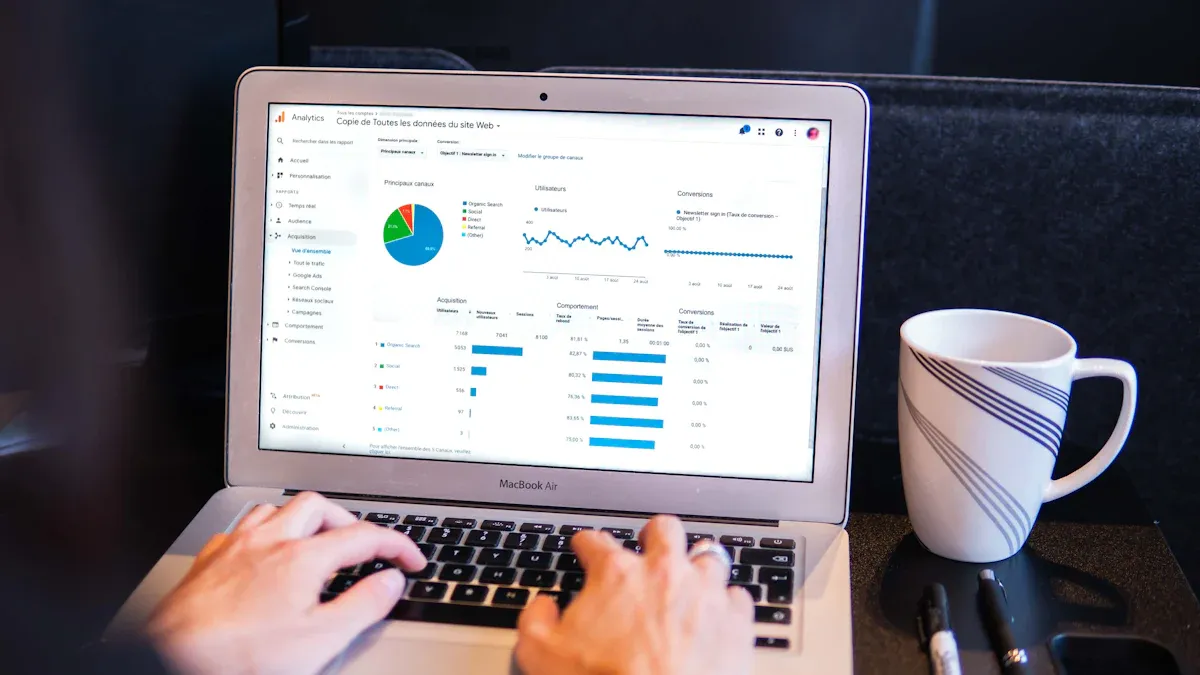
Predictive analytics transforms retail re-stocking from a reactive guessing game into a precise, data-driven science. This data-driven approach helps retail management improve inventory management. Retailers use historical data and real-time market trends for accurate retail demand forecasting. This forecasting allows businesses to automate ordering and maintain optimal inventory levels. Accurate forecasting slashes carrying costs and reduces stockouts. Better forecasting prevents customer loss. Effective retail demand forecasting provides accurate predictions. This forecasting ensures the right products are available for every customer. This forecasting helps retain the customer.
- Nearly 69% of online shoppers abandon their purchase and shop with a competitor if their desired item is out of stock.
- Stockouts account for 40% of lost sales as customers switch to competitors.
Predictive analytics offers a solution. It uses real-time forecasting for better retail demand forecasting. This forecasting keeps the customer happy. The forecasting process improves with more data. This is smart forecasting for the modern customer.
Core Predictive Analytics Strategies

Retailers in 2025 must adopt intelligent strategies to thrive. Predictive analytics offers a powerful toolkit for this purpose. These strategies transform inventory management from a reactive task into a proactive, profit-driving function. They enable precise retail demand forecasting and intelligent stock optimization. The result is a streamlined supply chain, higher ROI, and a superior experience for every customer. Effective planning is the foundation of these modern strategies.
Retail Demand Forecasting
Retail demand forecasting uses predictive analytics to estimate future product sales. This process goes far beyond looking at past sales figures. Modern forecasting incorporates a wide range of data to create accurate sales forecasts. Effective retail demand forecasting is the cornerstone of a successful supply chain strategy.
Advanced models analyze many variables to improve forecasting accuracy. These types of retail demand forecasting consider external factors that influence consumer behavior.
- Environmental Factors: Weather data helps predict demand for seasonal items like coats or ice cream.
- Holidays and Events: Models account for demand spikes from national holidays, local festivals, or major sporting events.
- Social Trends: Social media sentiment and online reviews offer real-time clues about a product's popularity.
- Economic Conditions: Broader economic indicators provide context for overall consumer spending habits.
Integrating these external factors can reduce forecasting errors by up to 37%. Machine learning algorithms like XGBoost excel at processing these complex datasets. For example, retail giant Walmart uses predictive analytics to analyze purchasing patterns, local events, and weather forecasts. This allows the company to dynamically adjust stock levels and improve product availability. Similarly, Levi's uses an AI-powered solution for its retail demand forecasting, creating a responsive model that evolves with new data. These advanced types of retail demand forecasting lead to significant operational gains. In fact, effective retail demand forecasting can reduce inventory costs by 15-25% within a year. This level of forecasting accuracy is essential for modern demand planning. The goal of these types of retail demand forecasting is to give the customer what they want, when they want it.
Dynamic Safety Stock Calculation
Safety stock is the extra inventory a retailer holds to prevent stockouts. Traditional methods use a fixed, static number. This old approach often leads to either costly overstocking or lost sales from understocking. Predictive analytics enables a much smarter approach: dynamic safety stock calculation. This method adjusts buffer inventory levels in real-time based on current conditions.
Pro Tip: Dynamic safety stock calculation is a key strategy for stock optimization. It balances the cost of holding inventory against the risk of losing a customer.
The table below shows the key differences between static and dynamic approaches.
| Feature | Static Safety Stock | Dynamic Safety Stock |
|---|---|---|
| Definition | A fixed buffer based on historical averages. | An adaptive buffer optimized with live data. |
| Updates | Reviewed quarterly or annually. | Recalibrated continuously in real-time. |
| Market Response | Reactive to market changes. | Proactive and responsive to volatility. |
| Disadvantages | High risk of stockouts or excess inventory. | Requires investment in technology and training. |
Dynamic calculations use advanced formulas for better planning. A common formula for this forecasting method is:
Safety Stock = Z-score × Standard Deviation of Demand × √Lead Time
Here, the Z-score represents the desired service level (e.g., ensuring an item is in stock 95% of the time). This data-driven technique ensures that safety stock levels are always aligned with current demand variability and supplier lead times. This is a core part of stock optimization. This planning helps businesses adapt quickly.
Automated Replenishment Triggers
Accurate forecasting and dynamic safety stock levels are powerful tools. Automated replenishment triggers put those insights into action. This strategy uses predictive analytics to automatically generate purchase orders when inventory hits a pre-defined level. This process eliminates manual errors and ensures timely restocking, which is crucial for supply chain optimization.
These automated systems integrate directly with a retailer's core technology.
- Warehouse Management Systems (WMS): The system pulls real-time inventory data from the WMS. When stock falls below a trigger point, it alerts the system. In automated warehouses, robots can even be directed to transport and restock items.
- Enterprise Resource Planning (ERP) Systems: Integration with an ERP ensures that purchase orders, financial data, and supply chain operations are all synchronized. This creates a seamless flow from prediction to procurement.
Finnish grocer Kesko uses an AutoStore system in its fulfillment center. This system automates stock updates for online grocery orders, ensuring optimal inventory levels. This type of automated inventory replenishment is becoming a standard for efficient operations. Implementing these strategies delivers a clear return. Many businesses achieve a positive ROI within 6 to 12 months. By automating the ordering process, retailers free up employees for more strategic tasks, improve stock optimization, and keep the customer satisfied with consistent product availability. This is the future of inventory planning.
A Roadmap to Predictive Implementation

Adopting predictive analytics requires a structured approach. This roadmap guides retailers through the essential stages of implementation. Following these steps ensures a smooth transition from traditional methods to intelligent, data-driven inventory management. The journey involves unifying data, selecting tools, validating models, and aligning teams for successful strategic planning.
Step 1: Unify Your Data Sources
The foundation of any successful predictive analytics strategy is high-quality, centralized data. Models are only as good as the information they receive. Retailers must first break down data silos and consolidate information from across the business. This unified view provides the complete picture needed for accurate forecasting.
Effective retail demand forecasting models draw from a wide array of sources. Key data inputs include:
- Historical sales data and regional trends
- Real-time market signals like social media sentiment and competitor pricing
- Supplier lead times and inventory levels from RFID sensors
- External factors such as weather patterns, local events, and economic indicators
- Customer behavior data, including web traffic and cart abandonment rates
Note: A clean dataset is a prerequisite for reliable forecasting. Dirty data, with its duplicates and inaccuracies, will undermine the entire predictive analytics effort.
Organizations should follow a systematic process for data hygiene. This planning ensures data integrity.
- Conduct a Data Audit. First, review all data systems to identify inconsistencies, duplicate records, and incomplete fields. This initial audit highlights problem areas that need immediate attention.
- Establish Data Standards. Next, create clear guidelines for data entry. Using standardized formats for addresses, phone numbers, and product categories prevents future quality issues.
- Deduplicate and Enrich Data. Use tools to find and merge duplicate customer or product records. After cleaning, enrich the data by filling in missing information from reliable external sources for a more complete view.
- Automate Cleaning Workflows. Finally, implement automated processes to clean and validate data as it enters the system. Automation maintains data quality over time and reduces manual effort.
Step 2: Select the Right Analytics Tools
With clean data in place, the next step is choosing the right technology. The market for advanced forecasting tools is diverse. The ideal solution depends on a retailer's size, budget, and technical expertise. A careful evaluation process is essential for selecting a platform that aligns with business goals and delivers a strong return on investment.
Retailers should consider several factors when evaluating advanced forecasting tools.
- Define Clear Use Cases: Identify the specific problems the tool needs to solve, such as reducing stockouts or optimizing promotional planning.
- Assess Technical Requirements: Determine if the team needs a user-friendly, no-code platform or has the expertise for a more complex solution.
- Evaluate Integration Capabilities: Ensure the tool can connect seamlessly with existing systems like ERP, POS, and e-commerce platforms.
- Consider Scalability: Choose a solution that can grow with the business, handling more data and complexity as operations expand.
A range of advanced forecasting tools serves different retail needs. Some platforms offer all-in-one solutions, while others specialize in specific areas. For example, Shopify provides AI-powered retail demand forecasting for its e-commerce users. Enterprise-level systems like RELEX Solutions and SAS Intelligent Planning offer powerful supply chain integration and scenario planning.
| Software | Best For | Key Features |
|---|---|---|
| Square | Small Business Owners | Real-time inventory updates, low-stock alerts, sales tracking |
| Lightspeed Retail | Multi-Location Stores | Centralized inventory, built-in POS, multi-channel sync |
| Cin7 | Growing Businesses | All-in-one inventory, POS, warehouse, and EDI solution |
Selecting the right software is a critical part of the planning process. It empowers the team with the capabilities needed for accurate forecasting and a better customer experience.
Step 3: Validating Your Forecasting Models
Implementing a predictive analytics model is not a one-time task. Retailers must continuously validate their forecasting models to ensure accuracy and reliability. Validation involves comparing the model's predictions against actual outcomes. This process helps refine the algorithms and builds confidence in the system's outputs. Accurate forecasting is essential for meeting customer demand.
To measure performance, businesses rely on specific Key Performance Indicators (KPIs). These metrics provide a clear, quantitative assessment of forecasting accuracy. A lower error rate indicates a more effective model, leading to better inventory decisions. This validation is a key part of the forecasting process.
| KPI | Definition | Why It Matters |
|---|---|---|
| Forecast Bias | Indicates if a model consistently over-predicts or under-predicts demand. | Helps identify and correct systematic errors in the forecasting logic. |
| MAPE | (Mean Absolute Percentage Error) Measures the average percentage error between forecasted and actual sales. | Provides an easy-to-understand measure of forecasting accuracy relative to sales volume. |
| WMAPE | (Weighted MAPE) Gives more weight to errors on high-value or high-volume products. | Focuses accuracy efforts on the items that have the biggest financial impact on the business. |
Regularly monitoring these KPIs allows teams to fine-tune their retail demand forecasting models. This iterative improvement is the core of a successful predictive analytics program. It ensures the forecasting remains sharp and responsive to changing market dynamics, ultimately satisfying the customer.
Step 4: Align Cross-Departmental Teams
Technology alone cannot guarantee success. The final step in the implementation roadmap is to align teams across the organization. Predictive analytics impacts nearly every department, from merchandising to marketing to finance. Fostering collaboration ensures that everyone understands the new processes and can leverage the insights from forecasting. This alignment is vital for effective planning.
A predictive analytics initiative requires a cultural shift toward data-driven decision-making.
- Merchandising and Buying Teams use forecasting to optimize assortments and make smarter purchasing decisions.
- Marketing Teams can align promotional campaigns with predicted demand spikes to maximize sales and customer engagement.
- Supply Chain and Operations rely on accurate forecasting for efficient warehouse management and logistics planning.
- Finance Teams use the predictions to manage cash flow and budget for inventory investments more effectively.
When all departments work from a single source of truth, the business operates more cohesively. This synergy improves efficiency, reduces costs, and creates a seamless experience for the customer. Successful implementation of predictive analytics transforms not just inventory management but the entire retail operation.
Benefits and Common Challenges
Implementing predictive analytics offers significant rewards but also presents unique challenges. Retailers can achieve new levels of efficiency and profitability. Success depends on understanding both the advantages and the potential obstacles. The primary benefits of retail demand forecasting include better financial performance and a stronger customer base.
The Goal of Stock Optimization
The main objective of stock optimization is to maximize profitability while minimizing costs. Predictive analytics achieves this by ensuring inventory levels meet customer demand without creating wasteful overstock. This process directly boosts a company's gross margin. For example, Swarovski saw its profits rise by 8% and deadstock fall by 29% after implementing smart stock optimization. This improved supply chain efficiency also reduces waste, aligning with sustainability goals. Effective stock optimization through accurate forecasting means products are sold quickly, turning inventory into revenue. This is one of the key benefits of retail demand forecasting.
Enhancing Customer Satisfaction
Consistent product availability is crucial for customer loyalty. When a desired item is out of stock, the customer experience suffers. Surveys show that 65% of shoppers will try a new brand if their first choice is unavailable. Predictive analytics prevents these situations. Accurate retail demand forecasting ensures shelves are full, which directly increases customer satisfaction. A happy customer is more likely to return. This positive experience improves key metrics like the Net Promoter Score (NPS), turning a one-time buyer into a loyal customer. This forecasting keeps the customer at the center of the strategy.
Overcoming Implementation Hurdles
Retailers face several common hurdles when adopting predictive analytics. Addressing these issues head-on is essential for successful stock optimization and retail demand forecasting. Strong forecasting depends on solving these problems.
A proactive approach turns these challenges into opportunities for growth and refinement in your predictive analytics strategy.
| Challenge | Practical Solution |
|---|---|
| Poor Data Quality | Implement routine data cleaning and validation processes. Establish a single source of truth to ensure consistency across all systems. |
| Demand Volatility | Use machine learning models that incorporate external signals like weather or local events. This makes forecasting adaptive. |
| Need for Skilled Personnel | Invest in training for current teams or hire data analysts. These experts can manage the technology and interpret forecasting insights. |
By tackling these issues, a business can fully leverage the power of predictive analytics for better stock optimization and retail demand forecasting.
In 2025, predictive analytics is a strategic imperative for retail management. It transforms inventory management from a reactive process to a proactive cycle. This new forecasting anticipates every customer need. The future of retail demand forecasting points to autonomous systems. This forecasting helps the customer. Effective retail demand forecasting is key. This forecasting satisfies the customer. Retail management should take the first step. Define business objectives for better retail demand forecasting. This forecasting improves the customer experience. An audit of data infrastructure prepares a business for predictive analytics. This retail demand forecasting makes accurate predictions for the customer. This is smart forecasting.
FAQ
What is predictive analytics for retail re-stocking?
Predictive analytics uses data to anticipate future inventory needs. This forecasting method helps businesses order the right amount of stock. This type of forecasting moves companies beyond simple historical sales analysis. Better forecasting prevents overstocking and stockouts, improving overall business health.
How does this forecasting benefit the customer?
This advanced forecasting ensures products are available when a customer wants them. A positive shopping experience builds loyalty. The customer avoids the frustration of finding an item out of stock. This focus on availability keeps the customer happy and encourages repeat business.
What data is needed for accurate forecasting?
Effective forecasting requires diverse data. Key inputs include historical sales, supplier lead times, and real-time market trends. This forecasting also uses external factors like weather and local events. Combining these sources makes the forecasting process much more precise.
Can small businesses use this type of forecasting?
Yes, small businesses can use predictive analytics. Many modern software platforms offer affordable, user-friendly forecasting tools. These systems provide powerful forecasting capabilities without needing a large data science team. This makes smart forecasting accessible to businesses of all sizes.
See Also
Forecasting Fashion: Balancing Supply and Demand with Predictive Insights
Future-Proofing Retail: 2025's Best Replenishment Strategies and Practices
Optimizing Retail: Streamlining Replenishment with 2024's Best Practices
Smart Choices: Data Analytics for Optimal Product Assortment